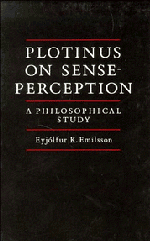Book contents
- Frontmatter
- Contents
- Acknowledgements
- Introduction
- I Plotinus' metaphysics
- II Plotinus' views on the soul and man
- III The relation between the eye and the object of vision
- IV Sensory affection
- V The unity of the senses
- VI The objects of perception
- VII Perceptions as acts and forms in perception
- VIII Conclusions
- Abbreviations
- Notes
- Bibliography
- Index
III - The relation between the eye and the object of vision
Published online by Cambridge University Press: 07 May 2010
- Frontmatter
- Contents
- Acknowledgements
- Introduction
- I Plotinus' metaphysics
- II Plotinus' views on the soul and man
- III The relation between the eye and the object of vision
- IV Sensory affection
- V The unity of the senses
- VI The objects of perception
- VII Perceptions as acts and forms in perception
- VIII Conclusions
- Abbreviations
- Notes
- Bibliography
- Index
Summary
It is a remarkable fact about vision that the things we see are at a distance from the organs through which we see them. Everyone who gives some thought to the phenomenon of vision is bound to speculate about this fact. It is evident that somehow the eye must be brought into contact with the object, but it is not at all apparent how this contact is established. The ancient Greek thinkers did not fail to apply their imagination and acumen to this matter. We have records of speculation on the subject from the times of Alcmaeon of Croton onwards. Our records suggest that this came to be a subject that every thinker felt obliged to have views about.
The Greek thinkers did not arrive at a solution in terms of light-reflection and light-waves such as that which we now accept, although some of them, Plotinus among others, approached it in some respects. One should not infer from their failure to find the correct solution that all their theories were nothing but idle speculation, that insofar as they hit upon some true insights this was more due to chance and luck than a careful study of the facts. In a way, the opposite is true. If we compare the Pre-Socratics’ doctrines about visual transmission with those debated in the first centuries AD, we can notice considerable progress and increasing sophistication. And although systematic experiments are lacking, many good observations were made. The thinkers of the second and third centuries whose discussions on this subject have come down to us – Alexander of Aphrodisias, Galen and Plotinus – all show considerable skill in testing the various theories against known observations.
- Type
- Chapter
- Information
- Plotinus on Sense-PerceptionA Philosophical Study, pp. 36 - 62Publisher: Cambridge University PressPrint publication year: 1988



